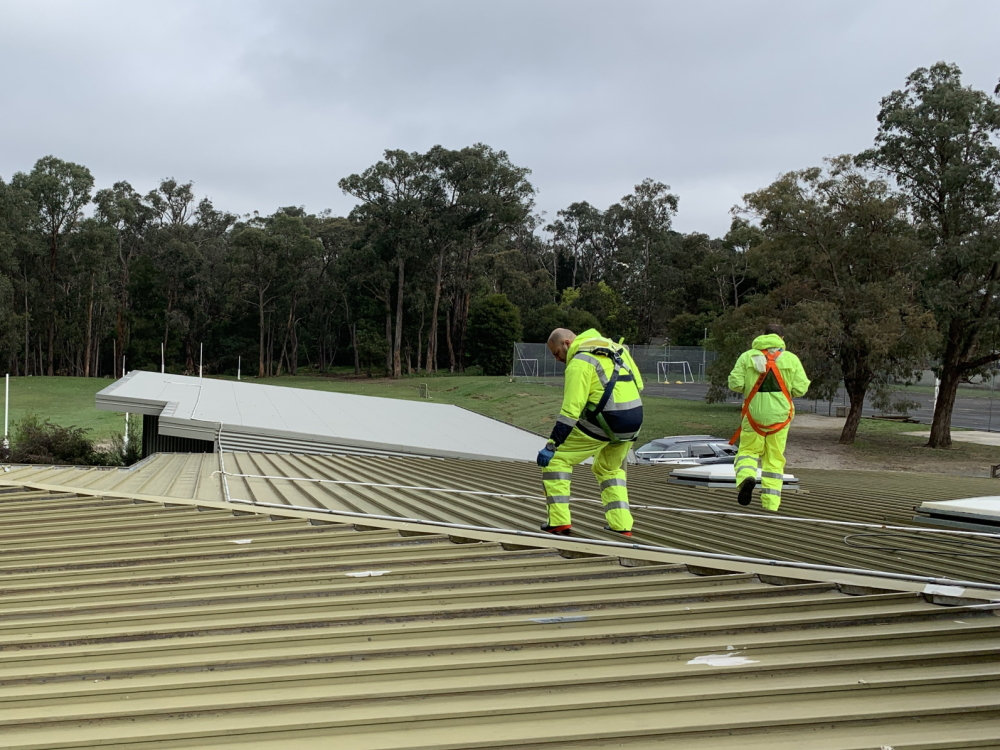Table Of Contents
Commercial painting projects demand careful planning and meticulous attention to safety protocols to ensure the well-being of workers and the public. From selecting the appropriate personal protective equipment (PPE) to implementing stringent safety measures on-site, prioritising health and safety is imperative in the painting industry.
In this extensive guide, we delve into the safety protocols for commercial painting projects, outlining what to expect regarding painting safety, safety measures, health and safety regulations, commercial paints, personal protective equipment (PPE), and the responsibilities of commercial painters. Let's dive in!
Understanding Painting Safety
Before anything else, it's important to have an in-depth understanding of painting safety, and here are the basic things you should know:

The significance of painting safety
The painting involves working with various chemicals, solvents, and materials that can pose health and safety risks if mishandled. Exposure to hazardous fumes, dust particles, and volatile organic compounds (VOCs), coupled with physical hazards such as falls and injuries from tools and equipment, underscores the importance of painting safety protocols.
Prioritising painting safety not only safeguards the health and well-being of workers but also mitigates the risk of accidents, injuries, and potential legal liabilities. By implementing comprehensive safety protocols and providing appropriate training and equipment, employers can foster a safer work environment for painters and other personnel involved in commercial painting projects.
Compliance with health and safety regulations
Commercial painters are subject to stringent health and safety regulations established by governmental agencies like the prestigious Occupational Safety and Health Administration (OSHA) in the United States or relevant authorities in other countries.
These regulations encompass hazard communication, respiratory protection, fall protection, scaffolding requirements, and other safety measures applicable to painting work.
Employers and painting contractors must ensure compliance with relevant health and safety regulations. This entails providing comprehensive training, conducting thorough risk assessments, and effectively implementing control measures to mitigate workplace hazards.
Health and Safety Measures
Here are some health and safety measures you should know:
Risk assessment and hazard mitigation
Before commencing any painting project, a thorough risk review should be performed to identify potential hazards and assess the risk associated with each task. Hazards such as chemical exposure falls from heights, and electrical hazards must be carefully evaluated to determine appropriate control measures.
Control measures may include implementing engineering controls, such as ventilation systems and containment barriers, to minimise exposure to hazardous substances. Additionally, administrative controls, such as job rotation and scheduled breaks, can help mitigate fatigue and reduce the risk of accidents.
Proper ventilation
Ensuring adequate ventilation is crucial for maintaining indoor air quality and minimising exposure to paint fumes, solvent vapours, and other airborne contaminants. Appropriate ventilation systems, such as exhaust fans and ventilation hoods, should be installed and maintained to effectively remove pollutants from the work area.
Safe handling and storage of materials
Commercial painters must adhere to safe handling and storage practices when working with commercial paints, solvents, and other chemicals. This includes following the manufacturer's instructions for use and storage, properly labelling containers, and storing hazardous materials in specified areas away from ignition sources.
Personal Protective Equipment (PPE) Requirements
Personal protective equipment is also vital for safety; here are the requirements to note:

Importance of PPE in commercial painting
Personal protective equipment (PPE) minimises exposure to hazards and prevents injuries in commercial painting. PPE is a barrier between employees and potential threats, protecting against chemical exposure, respiratory troubles, eye and face injuries, and other occupational risks.
Standard PPE for commercial painters
Commercial painters may be required to wear various types of PPE depending on the nature of the work and the hazards present. Common types of PPE for commercial painting include:
- Respiratory Protection: Respirators are essential for protecting against inhalation of paint fumes, dust particles, and other airborne contaminants. Depending on the level of respiratory protection required, painters may use disposable masks, half-face respirators, or powered air-purifying respirators (PAPRs).
- Eye and Face Protection: Safety glasses or goggles protect against eye injuries from splashes, spills, and airborne particles during painting operations. Face shields may also be necessary when working with high-pressure sprayers or abrasive blasting equipment.
- Protective Clothing: Painting overalls or coveralls protect against skin contact with paint, solvents, and other chemicals. Disposable suits or reusable garments made from durable, chemical-resistant materials are commonly used in commercial painting.
- Gloves: Chemical-resistant gloves protect the hands from exposure to paint, solvents, and abrasive materials. Nitrile, neoprene, or latex gloves offer adequate protection while allowing dexterity and grip for painting tasks.
Responsibilities of Commercial Painters
Commercial painters also have a role to play when it comes to safety. The responsibilities of commercial painters include the following:
Training and Education
Commercial painters should receive comprehensive training on painting safety, hazard identification, proper use of equipment, and emergency procedures. Ongoing education and training programs ensure painters stay up-to-date on the most delinquent safety protocols and industry best practices.
Compliance with regulations
Commercial painters are responsible for complying with all relevant health and safety regulations, including wearing appropriate PPE, following safe work procedures, and noting any hazards or incidents to their supervisors. Compliance with rules helps maintain safe working conditions and diminishes the risk of accidents and injuries.
Communication and Collaboration
Effective communication and collaboration are paramount for promoting a culture of safety on commercial painting projects. Painters should communicate openly with their supervisors and colleagues about safety concerns, hazards, and potential risks, fostering a collaborative approach to hazard identification and mitigation.
Hazardous Materials Management
Here's what you should know about handling and managing hazardous materials:

Identifying hazardous materials
Commercial painting often involves using various hazardous materials such as lead-based paints, solvents, and coatings containing volatile organic compounds (VOCs). Identifying these materials is crucial for implementing appropriate safety measures and minimising exposure risks.
Handling and storage procedures
Accurate handling and storage of hazardous materials are essential to prevent spills, leaks, and contamination. Painters should use designated containers and storage areas for hazardous materials, ensuring they are properly sealed and labelled according to regulatory requirements.
Waste management and disposal
Effective waste management and disposal practices are necessary to minimise environmental impact and comply with regulatory requirements. Painters must segregate hazardous waste from non-hazardous waste and dispose of it by local regulations. This may involve recycling, treatment, or disposal at authorised facilities.
Fall Protection Measures

Assessing fall hazards
Working at heights poses significant risks for commercial painters, making fall protection measures a top priority. Conducting a thorough assessment of fall hazards, such as elevated surfaces, ladders, scaffolding, and roof edges, is paramount for identifying possible risks and implementing appropriate controls.
Fall prevention and Arrest systems
Implementing fall prevention and arrest systems is critical for protecting painters from falls and reducing the severity of injuries in the possibility of a mishap. This may include installing guardrails, safety nets, and toe boards to prevent falls and providing personal fall arrest procedures, such as harnesses and lanyards, to arrest falls if they occur.
Training and supervision
Suitable training and management are essential for ensuring painters understand how to use fall protection equipment correctly and follow safe work practices when working at heights. Training should obscure topics such as hazard recognition, equipment inspection, proper anchorage, and emergency procedures in the event of a fall.
Emergency Preparedness and Response
Commercial painters should have comprehensive emergency response plans to address potential emergencies such as fires, chemical spills, and medical incidents. These plans should outline emergency procedures, evacuation routes, and designated assembly points to ensure a coordinated response in an emergency.
Maintaining emergency equipment such as fire extinguishers, first aid kits, and emergency eyewash stations is essential for responding effectively to emergencies. Painters should be trained in the proper use of emergency equipment and have access to communication apparatuses such as two-way radios or cell phones to summon assistance when needed.
Expertly Achieved Commercial Painting Safety Protocols
Defending the health and well-being of workers in commercial painting projects requires strict adherence to safety protocols, a task best entrusted to industry professionals. From conducting comprehensive risk assessments to implementing rigorous control measures and supplying appropriate personal protective equipment (PPE), prioritising safety is non-negotiable.
By partnering with experienced painting contractors who prioritise safety, employers can ensure compliance with health and safety regulations, mitigate workplace hazards, prevent injuries, and foster a culture of safety that promotes the overall well-being of workers.




